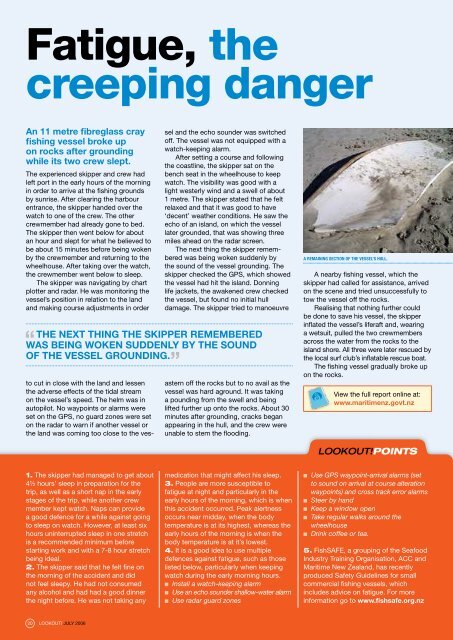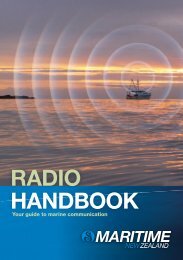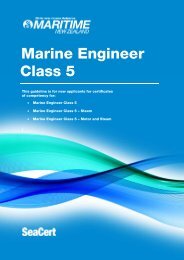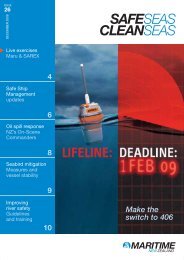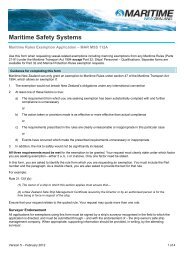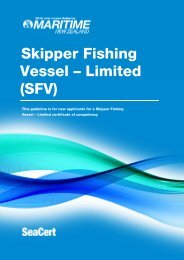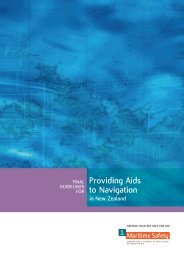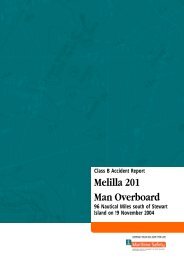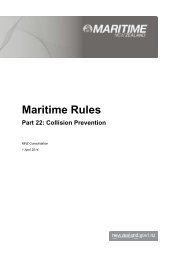You also want an ePaper? Increase the reach of your titles
YUMPU automatically turns print PDFs into web optimized ePapers that Google loves.
Fatigue, thecreeping dangerAn 11 metre fibreglass crayfishing vessel broke upon rocks after groundingwhile its two crew slept.The experienced skipper and crew hadleft port in the early hours of the morningin order to arrive at the fishing groundsby sunrise. After clearing the harbourentrance, the skipper handed over thewatch to one of the crew. The othercrewmember had already gone to bed.The skipper then went below for aboutan hour and slept for what he believed tobe about 15 minutes before being wokenby the crewmember and returning to thewheelhouse. After taking over the watch,the crewmember went below to sleep.The skipper was navigating by chartplotter and radar. He was monitoring thevessel’s position in relation to the landand making course adjustments in order1. The skipper had managed to get about4½ hours’ sleep in preparation for thetrip, as well as a short nap in the earlystages of the trip, while another crewmember kept watch. Naps can providea good defence for a while against goingto sleep on watch. However, at least sixhours uninterrupted sleep in one stretchis a recommended minimum beforestarting work and with a 7-8 hour stretchbeing ideal.2. The skipper said that he felt fine onthe morning of the accident and didnot feel sleepy. He had not consumedany alcohol and had had a good dinnerthe night before. He was not taking anyto cut in close with the land and lessenthe adverse effects of the tidal streamon the vessel’s speed. The helm was inautopilot. No waypoints or alarms wereset on the GPS, no guard zones were seton the radar to warn if another vessel orthe land was coming too close to the vesseland the echo sounder was switchedoff. The vessel was not equipped with awatch-keeping alarm.After setting a course and followingthe coastline, the skipper sat on thebench seat in the wheelhouse to keepwatch. The visibility was good with alight westerly wind and a swell of about1 metre. The skipper stated that he feltrelaxed and that it was good to have‘decent’ weather conditions. He saw theecho of an island, on which the vessellater grounded, that was showing threemiles ahead on the radar screen.The next thing the skipper rememberedwas being woken suddenly bythe sound of the vessel grounding. Theskipper checked the GPS, which showedthe vessel had hit the island. Donninglife jackets, the awakened crew checkedthe vessel, but found no initial hulldamage. The skipper tried to manoeuvreThe next thing the skipper rememberedwas being woken suddenly by the soundof the vessel grounding.astern off the rocks but to no avail as thevessel was hard aground. It was takinga pounding from the swell and beinglifted further up onto the rocks. About 30minutes after grounding, cracks beganappearing in the hull, and the crew wereunable to stem the flooding.medication that might affect his sleep.3. People are more susceptible tofatigue at night and particularly in theearly hours of the morning, which is whenthis accident occurred. Peak alertnessoccurs near midday, when the bodytemperature is at its highest, whereas theearly hours of the morning is when thebody temperature is at it’s lowest.4. It is a good idea to use multipledefences against fatigue, such as thoselisted below, particularly when keepingwatch during the early morning hours.■ Install a watch-keeping alarm■ Use an echo sounder shallow-water alarm■ Use radar guard zonesA remaining section of the vessel’s hull.A nearby fishing vessel, which theskipper had called for assistance, arrivedon the scene and tried unsuccessfully totow the vessel off the rocks.Realising that nothing further couldbe done to save his vessel, the skipperinflated the vessel’s liferaft and, wearinga wetsuit, pulled the two crewmembersacross the water from the rocks to theisland shore. All three were later rescued bythe local surf club’s inflatable rescue boat.The fishing vessel gradually broke upon the rocks.View the full report online at:www.maritimenz.govt.nzLookout!Points■ Use GPS waypoint-arrival alarms (setto sound on arrival at course alterationwaypoints) and cross track error alarms■ Steer by hand■ Keep a window open■ Take regular walks around thewheelhouse■ Drink coffee or tea.5. FishSAFE, a grouping of the SeafoodIndustry Training Organisation, ACC and<strong>Maritime</strong> <strong>New</strong> <strong>Zealand</strong>, has recentlyproduced Safety Guidelines for smallcommercial fishing vessels, whichincludes advice on fatigue. For moreinformation go to www.fishsafe.org.nzA momentsdistractionis all it takesA stevedore foreman working on aninternational container vessel was hit by aswinging pontoon hatch lid and sustainedserious injuries.The stevedore was part of a crewloading and discharging containers inwind gusting up to 35 knots. The hatchlid was being lifted by crane and thestevedore and a mate were positioned1. The stevedore was properly positionedto guide the pontoon lid into its housing,with room on either side to move outFailed hoistwire not up tospecificationA 27 tonne load of grabbed coalsmashed suddenly and without warningonto the main deck of an 18 000 grosston bulk/log carrier, when a ship’s cranehoist-wire failed. The main deck platingwas dented to a depth of about 25mm,but was not pierced. There were noinjuries to the stevedores or crew.After the accident, the crew changedthe hoist wire on the affected crane andchecked the hoist wires and associated1. The cargo gear had undergone prooftesting and a five-year thorough examinationby the ship’s classification societyabout 1 year before the accident.2. The point where the hoist wire partedwas near the right hand sheave at the topof the crane. The point where the otherwire partially failed was on the left handside of the crane jib.on either side of the stowing position,intending to help guide the pontoon lidinto place. The stevedore momentarilybecame distracted, possibly by hishand-held VHF radio. At that moment alarge gust of wind caught the pontoon lid,making it swing suddenly in his direction.The stevedore was pinned againsta ‘wall’ of containers by the pontoonof the way if necessary. However, hedid not see the lid swinging toward himbecause he had become distracted. Evencargo gear on the remaining three ship’scranes for any defects; no defects werefound at that stage. Each crane had anSWL of 30 tonnes. However, sometimeafter cargo work resumed, a secondcrane driver noticed that one strand onhis hoist wire had also parted, and theunloading of the coal cargo was stoppedat all hatches. Upon inspection, two ofthe four crane hoist wires were found tobe four-stranded wire with 39 wires per3. After the accident, an equivalentweight of coal and the grab that wasbeing used at the time was weighed.Weighbridge dockets showed thecombined weight to be 27.56 tonnes.4. After the accident, the ship’s masterwas instructed that none of the craneswas to be used to work cargo until theirhoist wires had been replaced.the hatch lid that trapped the stevedore foreman.lid and suffered nine broken ribs and apunctured lung as a result of the accident.He was rushed to hospital and wasdischarged eight days later.View the full report online at:www.maritimenz.govt.nzLookout!Pointsthough this stevedore had many years’experience, remaining vigilant during keyoperations, every time, is vital.strand, rather than the specified fourstrandedwire with 48 wires per strand.The thinner wires would havebeen less flexible, and more prone tometal fatigue as they passed through thecranes’ eight sheaves.the grab after falling onto the vessel’s deck.View the full report online at:www.maritimenz.govt.nzLookout!Points5. Two of the replacement hoistwires held on board the vessel werealso found to be the wrong size. Therewere no documented procedures in theship’s ISM documentation to ensure thathoist wires met design specificationsand construction.20 LOOKOUT! JULY <strong>2006</strong>LOOKOUT! JULY <strong>2006</strong> 21


